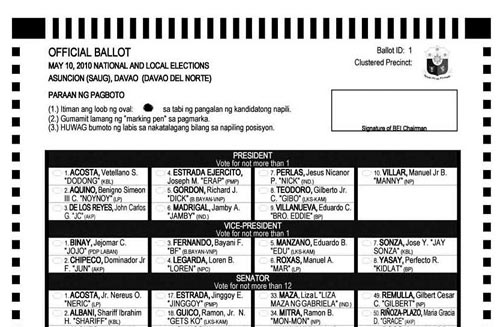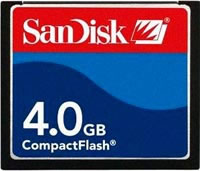Problem of the CF Cards
By Pablo Manalastas, Ph. D.
In the news article entitled, "Comelec to Erap: Prove allegations", in the May 16, 2010 issue of Philippine Star, Comelec spokesman James Jimenez is quoted as saying,
"Compact flash cards have nothing to do with the count, all it does is say that 'you machine, you are for this precinct'. Basically, what a compact flash card does is to customize a machine so that it is specific to a particular locality and that's all that it does. It has nothing to do with the counting logic."
That the CF card has nothing to do with the counting logic is the BIGGEST LIE ever to come from Comelec. The CF card contains data that are the very heart and soul of the counting logic, such that use of the wrong CF card produces wrong counts, and puts to question the entire result of the May 10, 2010 automated election.
Precinct-Specific Ballots and CF Card
All the 76,000+ PCOS machines are running the same computer program that reads ballots, credits the votes to the correct candidates, computes a summary at the end of the voting period, and transmits the election return to the municipal board of canvassers and to the national Comelec servers. An unconfigured generic PCOS machine can be used in any of the 76,000+ precincts. What enables the PCOS machine to count votes for candidates of a specific municipality/district is the candidates' data in the CF card that is used to configure the PCOS machine. The CF card tells the PCOS machine what the names of the candidates are and the positions of their ovals on the ballot.
Take the example of the candidates for president, as shown in this sample ballot.

Let us assume a scan resolution of 100 pixels per inch, so that a ballot with dimensions 8.5 inches x 25 inches will be scanned and saved as a tiff file of 850 pixels x 2500 pixels. Let us take as origin the upper-left corner of the black rectangle on the upper-left corner of the ballot as horizontal-x pixel position and vertical-y pixel position (0,0). Then the center of the oval for candidate Acosta is at position (70, 260), and the center of the oval for candidate Aquino is at position (70, 290). Candidates Acosta and Aquino are in the same column and so have the same horizontal-x position at pixel 70. Also, the center of the oval for candidate Estrada is at position (245, 260). Now candidates Acosta and Estrada are in the same row and so have the same vertical-y position at pixel 260. Thus the ballot design tells us which candidate has his oval on which (x,y)-position on the ballot. All these data on names and (x,y)-positions on the ballot for each candidate are stored in the CF card for the precinct. The CF card is a memory card that looks like the picture below. It is similar in use to SD cards, MMC cards, and USB pendrives, in that it is used to store files containing data. In the case of a CF card for a PCOS machine, the CF card contains data on candidates names and their (x,y)-positions on the ballot to be used in that precinct.
 It is important that the ballots to be used for a specific precinct and the CF card to be used to configure the PCOS machine for that precinct be exactly matched in terms of the names of candidates and their positions on the ballots. A vote for candidate Acosta at position (70, 260) on the ballot will be interpreted correctly or incorrectly by the PCOS machine depending on the correctness of the data on the CF card. We can see three possibilities.
It is important that the ballots to be used for a specific precinct and the CF card to be used to configure the PCOS machine for that precinct be exactly matched in terms of the names of candidates and their positions on the ballots. A vote for candidate Acosta at position (70, 260) on the ballot will be interpreted correctly or incorrectly by the PCOS machine depending on the correctness of the data on the CF card. We can see three possibilities.
- If the CF card data has Acosta in position (70, 260), then the vote on the ballot will be correctly credited to Acosta.
- If the CF card data has Acosta in position slightly different from (70, 260), say the CF card has (75, 260) as the position of Acosta's oval, then the vote on the ballot for Acosta may or may not be credited to him, depending on whether the shading centered at (70, 260) constitutes a 50% or greater shading of the oval centered at (75, 260).
- If on the CF card, Aquino's oval is indicated as the one centered at position (70, 260),then the vote for Acosta will be credited as a vote for Aquino.
Thus it is important that all data on the CF card for a precinct exactly match all the candidates' names and (x, y)-positions on the ballots for the precinct, for otherwise, the votes cast will not be correctly credited to the selected candidates.
Role of the EMS Program
Fortunately, Smartmatic has the Election Management System (EMS) program to do all of the following (1) produce the camera-ready ballot faces to be used for printing the ballots for a specific precinct, (2) write data to the CF card for that precinct, (3) ensure that ballot faces produced in Step-1, and the CF card produced in Step-2 are exactly matched, and (4) Repeat Steps 1-2-3 for all of the 76,000+ precincts.
Why the Mismatch Between Ballots and CF Cards on May 3?
I can only make an educated guess, because Comelec has never been transparent in everything that it does, but has always claimed transparency in everything that it does. Being transparent, and claiming transparency, are two different animals altogether.
This is my guess. Smartmatic-Comelec must have gone through several iterations of ballot design and CF card production, considering that it changed the ballot design from vertical enumeration for a position, to horizontal enumeration, and considering that new names had to be added to the ballot from time to time, to accommodate new decisions about candidates made by the Supreme Court and by Comelec itself. In the latest iteration, Smartmatic-Comelec produced the final version of the ballot, but forgot to produce the CF cards for the new ballot design. Instead, Smartmatic-Comelec shipped the latest ballot design with the old CF cards. So, during the May 3, 2010 final testing and sealing (FTS) step, almost all PCOS machines failed in NCR, and Comelec had to stop the FTS, and Smartmatic promised that a new batch of 76,000+ CF cards will be produced and delivered to the precincts in time for election on May 10.
To date, Comelec has not reported to the Filipino people how many of the 76,000+ new CF cards reached the correct destination precincts AND successfully passed FTS before 7:00AM on election day, May 10, 2010, because only in these precincts will the count be correct.
Should We Believe the Comelec Tabulation/Canvass?
Comelec must prove beyond reasonable doubt that it only used election returns from consolidated precincts that used only CF cards that passed FTS, because only such precincts will produce correct counts. It does not matter whether the paper ballots were fed to the PCOS machine by the voters themselves on election day, or batch-fed by the BEI to the PCOS machine after election day because the CF card arrived late and was tested late, as long as there are voters, watchers, and party representatives to witness the process and authorized people to sign the printed election return.
- Probing presidential platforms
- Conference calls for people-centered policy actions for Asian development and peace
- WWII 'comfort women' urge visiting Japanese emperor: OFFICIAL GOV’T APOLOGY, UPHOLD TRUTH, and JUST COMPENSATION
- FEARLESS FORECAST (EPISODE II): Comelec will not comply with e-Commerce Law in 2016 elections
- Fearless forecast: Comelec’s non-compliance with the AES law in 2016 (last of 2 parts)
- Fearless forecast: Comelec will not comply with the AES law in 2016
- CenPEG releases travelogue
- Experts: Nuisance bets reflect disillusionment, uneven playing field
- Partylist solon presses for tax cuts
- The True Cost of a Political Campaign
- Management decisions: Based on RA 9369 or purely Comelec’s?
- CenPEG holds 1st roundtable with media on presidential poll results
- Filipino IT can do it!
- FIT4E: The only transparent solution
- Realpolitik in the maritime tiff
- China’s challenge to PH sovereignty
- Choosing the next president
- Fixing the presidency, reforming the state
- New Comelec chair says he’s open to other election technologies
- SC ruling on AES Watch Pabillo and IBP vs Comelec, Smartmatic-TIM
- Comelec must explain P3.2B unliquidated cash advances
- CONGRESS ASKED TO HOLD DEMO ON PCOS HACKING
- 25 Bishops ask poll body to stop midnight deal with Smartmatic
- Pope Francis: reform and conversion
- 2 poll watch coalitions stage rally vs Comelec-Smartmatic midnight deal
- AES Watch questions Comelec-Smartmatic midnight deal
- ASEAN-India: Building Youth Partnerships through Culture and Entrepreneurship
- CenPEG forges research exchange and partnership with Jinan University
- FOI: Bearing fruit or foiled again?
- Remittance with Representation: The right to vote of overseas Filipinos
Center for People Empowewrment in Governance (CenPEG), Philippines. All rights reserved


